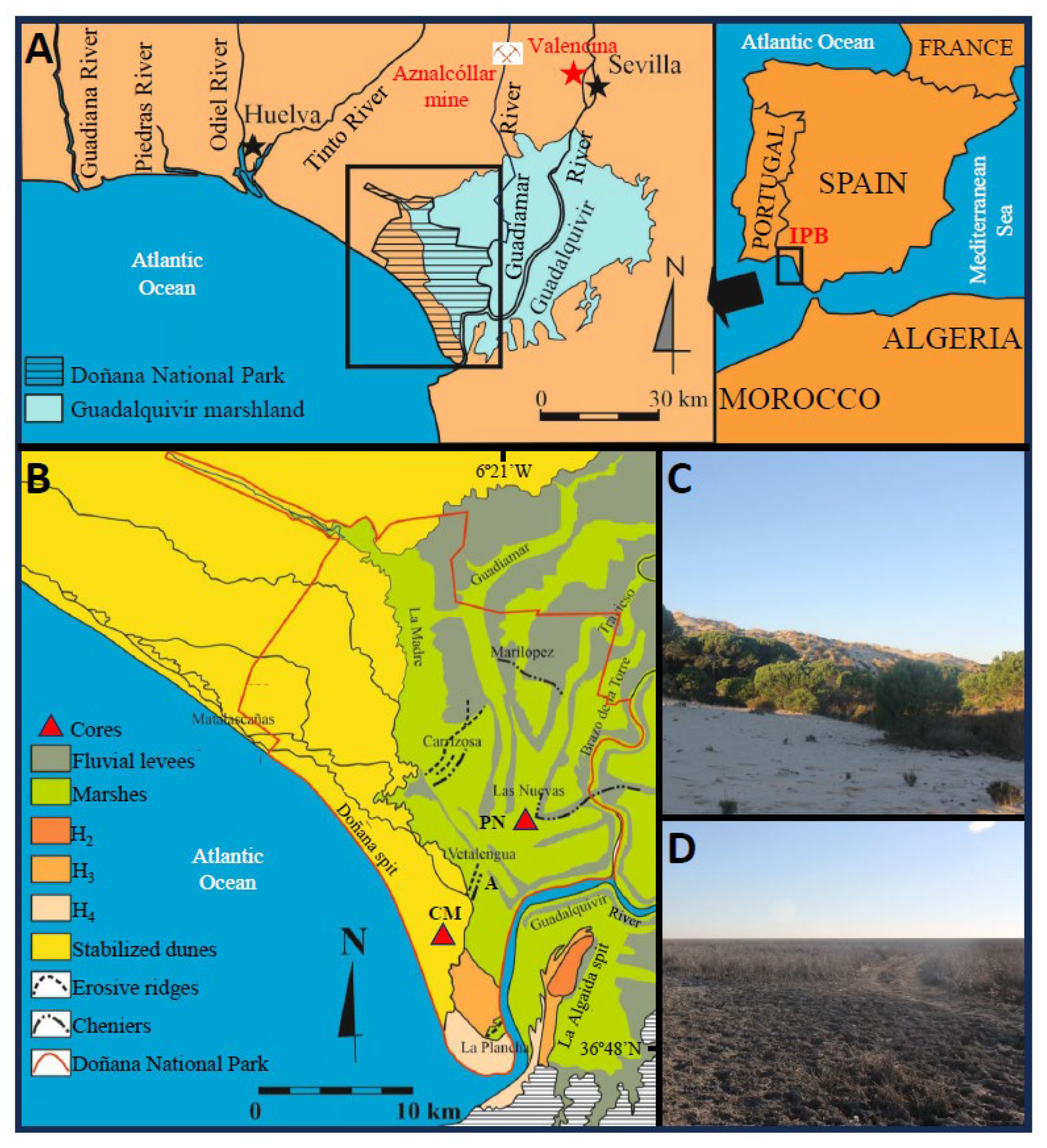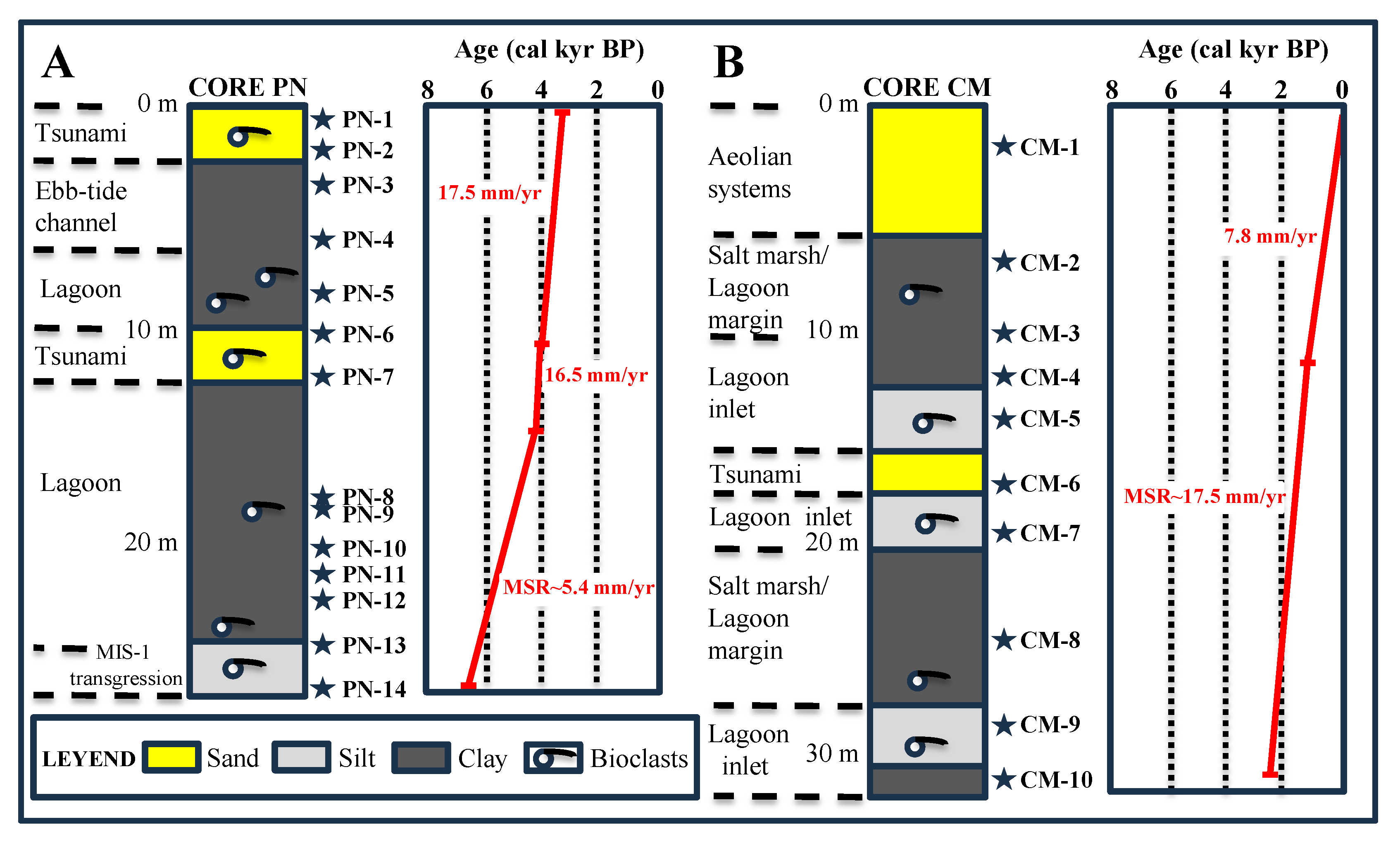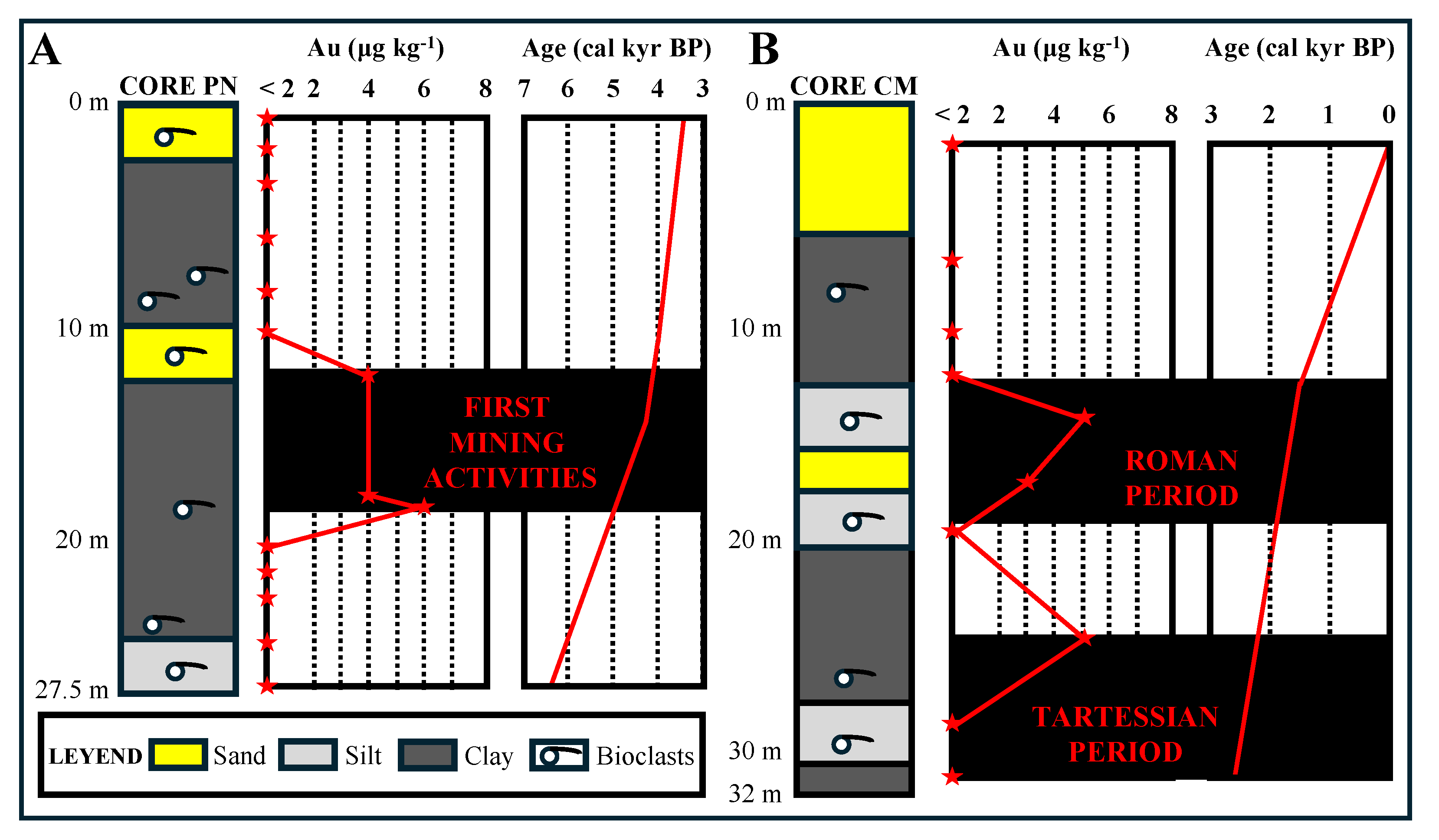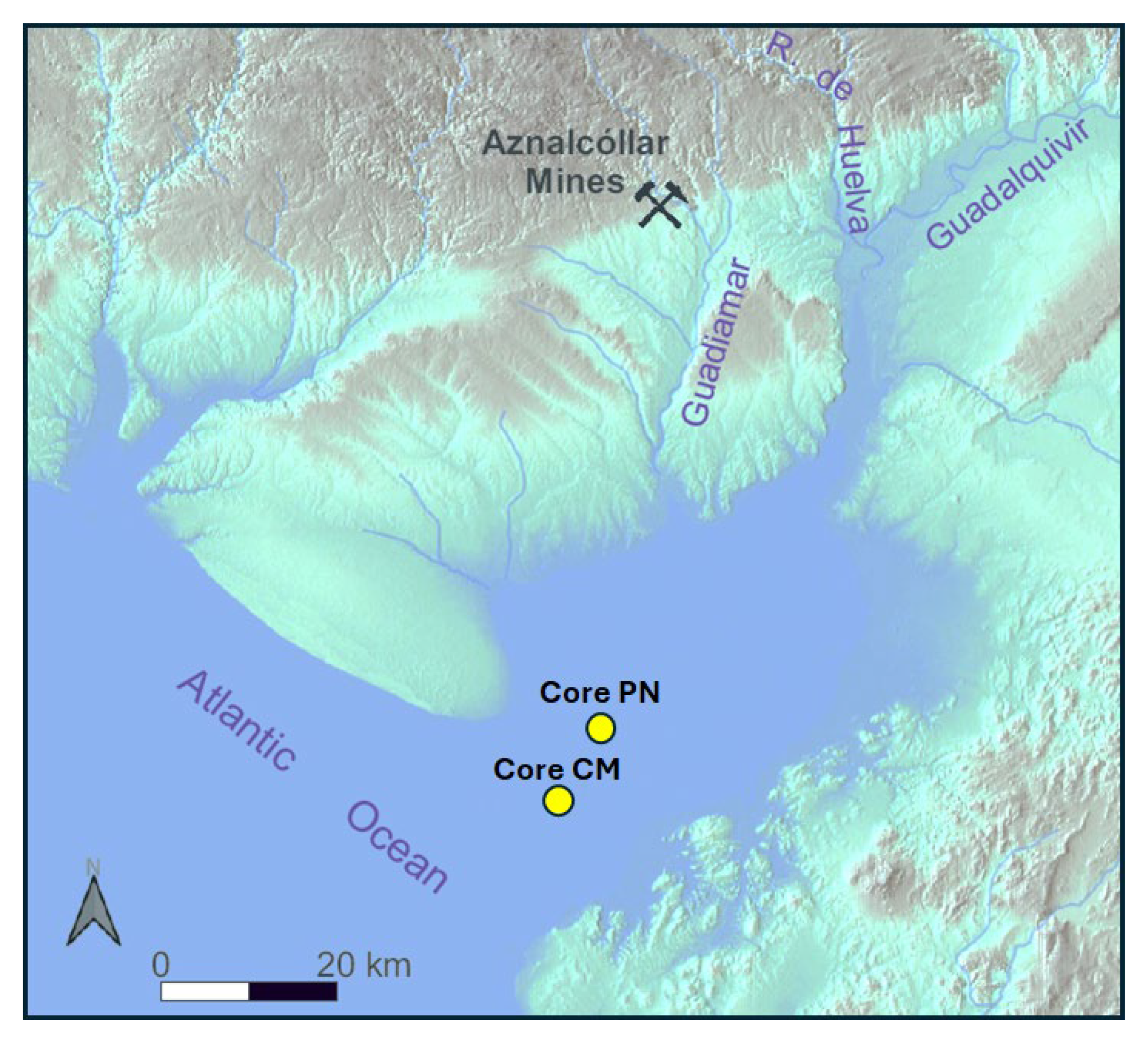Gold as Pollution Tracer in Holocene Sediments of the Doñana National Park, the Largest Biological Reserve in Europe
Abstract
1. Introduction
2. Materials and Methods
2.1. Study Area
2.2. Cores: Paleoenvironmental Reconstruction
2.3. Sampling and Geochemical Analysis
2.4. Dating
3. Results and Discussion
3.1. Dating and Depth-Age Models of Cores
3.2. Vertical Distribution of Au
3.3. Au as Prehistorical and Historical Pollution Tracer
3.4. Au vs. Other Pollution Tracers
4. Conclusions
Author Contributions
Funding
Data Availability Statement
Conflicts of Interest
References
- Ghanem, A.; Nada, A.; Abu-Zeid, H.; Madcour, W.; Shetaia, S.A.; Imam, N. Historical trends of heavy metals applying radio-dating and neutron activation analysis (NAA) in sediment cores, Burullus Lagoon, Egypt. Environ. Sci. Pollut. Res. 2024, 31, 43633–43658. [Google Scholar] [CrossRef]
- Zhang, S.; Li, Q.; Zou, Y.; Liu, B.; Yang, J.; Zheng, H.; Liu, G. Using isotopic lead and strontium in sediments to trace natural and anthropogenic sources in the Bohai Sea. Sci. Rep. 2024, 14, 30267. [Google Scholar] [CrossRef]
- Nagarajan, A.; Dharmalingam, S.N.; Jeyasingh, V.; Jayaseelan, C.; Vijayaprabhakaran, K. Heavy metals in core sediments from the western Bay of Bengal: Implications on historical pollution, eco-environmental risks, and potential sources. Anthr. Coasts 2024, 7, 26. [Google Scholar] [CrossRef]
- Ahmad, M.Z.; Singh, P. Geochemistry of core sediments from Cauvery delta South-East India: Inferences on weathering and paleo-redox conditions. Quaternaire 2023, 34, 18588. [Google Scholar]
- Tornos, F.; López, E.; Sánchez, F.J. The Iberian Pyrite Belt. In Contextos Geológicos Españoles: Una Aproximación al Patrimonio Geológico de Relevancia Internacional; García-Cortés, A., Ed.; Instituto Geológico y Minero de España: Madrid, Spain, 2008; pp. 56–64. [Google Scholar]
- Delgado, J.; Boski, T.; Nieto, J.; Pereira, L.; Moura, D.; Gomes, A.; Sousa, C.; García-Tenorio, R. Sea-level rise and anthropogenic activities recorded in the late Pleistocene/Holocene sedimentary infill of the Guadiana Estuary (SW Iberia). Quat. Sci. Rev. 2012, 33, 121–141. [Google Scholar] [CrossRef]
- Leistel, J.M.; Marcoux, E.; Deschamps, Y.; Joubert, M. Antithetic behaviour of gold in the volcanogenic massive sulphide deposits of the Iberian Pyrite Belt. Miner. Depos. 1997, 33, 82–97. [Google Scholar] [CrossRef]
- Velasco, F. El oro asociado a los sulfuros masivos de la Faja Pirítica Ibérica. Macla 2014, 19, 1. [Google Scholar]
- Yesares, L.; Ruiz de Almodóvar, G.; Sáez, R.; Proenza, J.A.; Pons, J.M. Mineralizaciones de oro en los sulfuros masivos de la Faja Pirítica Ibérica. Macla 2019, 24, 121–122. [Google Scholar]
- Cáceres, L.M.; Ruiz, F.; Bermejo, J.; Fernández, L.; González-Regalado, M.L.; Rodríguez Vidal, J.; Abad, M.; Izquierdo, T.; Toscano, A.; Gómez, P.; et al. Sediments as sentinels of pollution episodes in the middle estuary of the Tinto River (SW Spain). Minerals 2023, 7, 95. [Google Scholar] [CrossRef]
- Davis, R.A.; Welty, A.T.; Borrego, J.; Morales, J.A.; Pendón, J.G.; Ryan, J.G. Rio Tinto estuary (Spain): 5000 years of pollution. Environ. Geol. 2000, 39, 1107–1119. [Google Scholar] [CrossRef]
- Ruiz, F.; Rodríguez Vidal, J.; Cáceres, L.M.; Olías, M.; González-Regalado, M.L.; Campos, J.M.; Bermejo, J.; Abad, M.; Izquierdo, T.; Carretero, M.I.; et al. Silver and copper as pollution tracers in Neogene to Holocene estuarine sediments from southwestern Spain. Mar. Pollut. Bull. 2020, 150, 110704. [Google Scholar] [CrossRef] [PubMed]
- Fernández Jurado, J. Economía tartésica: Minería y metalurgia. Huelva Hist. 1986, 1, 149–170. [Google Scholar]
- Escacena, J.L.; Feliu, M.J.; Izquierdo, R. El Cerro de La Albina y la metalurgia de la plata en Tartessos. De Re Met. (Madr.) Rev. De La Soc. Española Para La Def. Del Patrim. Geológico Y Min. 2010, 14, 35–51. [Google Scholar]
- Dabrio, C.J.; Zazo, C.; Lario, J.; Goy, J.L.; Sierro, F.J.; Borja, F.; González, J.A.; Flores, J.A. Sequence stratigraphy of Holocene incised-valley fills and coastal evolution in the Gulf of Cádiz (southern Spain). Geol. En Mijnb. 1998, 77, 263–281. [Google Scholar] [CrossRef]
- Rodríguez-Ramírez, A.; Villarías-Robles, J.J.R.; Pérez-Asensio, J.N.; Santos, A.; Morales, J.A.; Celestino-Pérez, S.; León, A.; Santos-Arévalo, F.J. Geomorphological record of extreme wave events during Roman times in the Guadalquivir estuary (Gulf of Cadiz, SW Spain): An archaeological and paleogeographical approach. Geomorphology 2016, 261, 103–118. [Google Scholar] [CrossRef]
- Ayala-Carcedo, F.J. La rotura de la balsa de residuos mineros de Aznalcóllar (España) de 1998 y el desastre ecológico consecuente del río Guadiamar: Causas, efectos y lecciones. Bol. Geol. Min. 2004, 115, 711–738. [Google Scholar]
- Pozo, M.; Ruiz, F.; Carretero, M.I.; Rodríguez Vidal, J.; Cáceres, L.M.; Abad, M.; González-Regalado, M.L. Mineralogical assemblages, geochemistry and fossil associations of Pleistocene-Holocene complex siliciclastic deposits from the Southwestern Donana National Park (SW Spain): A palaeoenvironmental approach. Sediment. Geol. 2010, 225, 1–18. [Google Scholar] [CrossRef]
- Prudêncio, M.I.; Ruiz, F.; Marques, R.; Dias, M.I.; Vidal, J.R.; Rodrigues, A.L.; Cáceres, L.M.; González-Regalado, M.L.; Muñoz, J.M.; Pozo, M.; et al. REE Geochemistry of Neogene–Holocene Sediments of La Fontanilla Cove (Tinto Estuary, SW Spain). Minerals 2022, 12, 417. [Google Scholar] [CrossRef]
- Martins, J.M.M.; Soares, A.M.M. Marine radiocarbon reservoir effect in southern Atlantic Iberian coast. Radiocarbon 2013, 55, 1123–1134. [Google Scholar] [CrossRef]
- Rodríguez-Ramírez, A.; Pérez-Asensio, J.N.; Santos, A.; Jiménez-Moreno, G.; Villarías-Robles, J.J.R.; Mayoral, E.; Celestino-Pérez, S.; Cerrilo-Cuenca, E.; López-Sáez, J.A.; León, A.; et al. Atlantic extreme wave events during the last four millennia in the Guadalquivir estuary, SW Spain. Quat. Res. 2015, 83, 24–40.
- González-Regalado, M.L.; Monge, G.; Carretero, M.I.; Pozo, M.; Rodríguez-Vidal, J.; Cáceres, L.M.; Abad, M.; Campos, J.M.; Bermejo, J.; Tosquella, J.; et al. Imprints of historical pollution and the 218-60 BCE tsunamigenic period in southwestern Spain. Rev. Mex. Cienc. Geol. 2020, 37, 89–97. [Google Scholar] [CrossRef]
- Lario, J.; Zazo, C.; Goy, J.L.; Dabrio, C.J.; Borja, F.; Silva, P.G.; Sierro, F.; González, A.; Soler, V.; Yll, E. Changes in sedimentation trends in SW Iberia Holocene estuaries (Spain). Quat. Int. 2002, 93–94, 171–176. [Google Scholar] [CrossRef]
- Tornos, F. La geología y metalogenia de la Faja Pirítica Ibérica. Macla 2008, 10, 13–23. [Google Scholar]
- Nocete, F.; Queipo, G.; Sáez, R.; Nieto, J.M.; Inacio, N.; Bayona, M.R.; Peramo, A.; Cruz-Auñón, R. Specialised copper industry in the political centres of the Guadalquivir Valley during the Third Millennium BC: The smelting quarter of Valencina de la Concepción, Sevilla, Spain (2750–2500 BC). J. Archaeol. Sci. 2008, 35, 717–732. [Google Scholar] [CrossRef]
- Pérez Macías, J.A.; Delgado Domínguez, A. Ingeniería minera antigua y medieval en el suroeste ibérico. Boletín Geológico Y Min. 2011, 122, 3–16. [Google Scholar]
- Cáceres, L.M.; Donaire, T.; Ramírez-Cruzado, S.; Vargas, J.M.; Muñiz, F.; Martín, M.; Rodríguez Vidal, J.; Ruiz, F.; García Sanjuán, L. From the Mountain and the Sea: Provenance of the Stones of the Prehistoric La Pastora Tholos (Valencina de la Concepción, Seville, Spain). Minerals 2024, 14, 194. [Google Scholar] [CrossRef]
- Alvarez, B.C. La civilización tartésica. Hist. Digit. 2016, 16, 98–135. [Google Scholar]
- Pérez Macías, J.A. Las minas de Tarteso. In Tarteso. El Emporio del Metal; Alvar, J., Campos, J.M., Eds.; Archaeopress Publishing Ltd.: Córdoba, Spain, 2013; pp. 449–472. [Google Scholar]
- Ferrer, E.; García, F.J. La crisis de Tarteso y el problema del siglo V a.C. en el ámbito geográfico turdetano. Anales Arqueol. Cordob. 2019, 30, 51–76. [Google Scholar]
- Carrasco, J.L.E. Indicadores étnicos en la Andalucía prerromana. Spal 1992, 1, 321–343. [Google Scholar]
- Strabo. Geografía. Libros III–IV; Biblioteca Clásica de Gredos: Madrid, Spain, 1992; Volume 169. [Google Scholar]
- Pérez Macías, J.A. Pico del Oro (Tharsis, Huelva). Contraargumentos sobre la crisis metalúrgica tartéssica. Huelva Hist. 1999, 7, 71–98. [Google Scholar]
- Amores, F.; García, E.; Garrido, P.; Hunt, M.A.; Vázquez, J.; Rodríguez, J. Los paisajes históricos del Valle del Guadiamar (Sevilla): La minería y la metalurgia en el extremo oriental del Cinturón Ibérico de Piritas. Cuad. De Prehist. Y Arqueol. De La Univ. De Granada 2014, 24, 203–237. [Google Scholar] [CrossRef]
- Mil-Homens, M.; Vale, C.; Naughton, F.; Brito, P.; Drago, T.; Anes, B.; Raimundo, J.; Schmidt, S.; Caetano, M. Footprint of roman and modern mining activities in a sediment core from the southwestern Iberian Atlantic shelf. Sci. Total Environ. 2016, 571, 1211–1221. [Google Scholar] [CrossRef] [PubMed]




| Core | Depth (m) | Laboratory Number | 14C Age Yr BP | Error | Age Cal Yr BP (2σ) |
|---|---|---|---|---|---|
| PN | 0.3 | B-228880 | 3550 | 40 | 3215–3580 |
| 10.8 | B-228881 | 4060 | 40 | 3845–4256 | |
| 14.1 | B-228885 | 4200 | 40 | 4026–4433 | |
| 26.1 | B-228882 | 6090 | 40 | 6270–6619 | |
| CM | 11.7 | B-228873 | 2030 | 40 | 1370–1714 |
| 31 | B-228876 | 2830 | 40 | 2349–2704 |
| Core | Sample/Element | Au | Ag | Cu | Pb | Zn |
|---|---|---|---|---|---|---|
| CM | CM-1 | <2 | <0.3 | 4 | 5 | 9 |
| CM-2 | <2 | 0.3 | 33 | 41 | 81 | |
| CM-3 | <2 | <0.3 | 29 | 37 | 75 | |
| CM-4 | <2 | <0.3 | 30 | 35 | 71 | |
| CM-5: Roman pollution | 5 | <0.3 | 19 | 25 | 46 | |
| CM-6 | 3 | <0.3 | 5 | 7 | 7 | |
| CM-7 | <2 | <0.3 | 12 | 21 | 28 | |
| CM-8: Tartessian pollution | 5 | 0.6 | 46 | 46 | 74 | |
| CM-9 | <2 | 0.4 | 5 | 7 | 12 | |
| CM-10 | <2 | <0.3 | 3 | 6 | 9 | |
| PN | PN-1: Tsunami | <2 | <0.3 | 22 | 21 | 61 |
| PN-2: Tsunami | <2 | 0.3 | 24 | 18 | 68 | |
| PN-3 | <2 | 0.4 | 37 | 54 | 79 | |
| PN-4 | <2 | 0.4 | 32 | 46 | 75 | |
| PN-5 | <2 | 0.4 | 27 | 32 | 62 | |
| PN-6: Tsunami | <2 | <0.3 | 28 | 15 | 61 | |
| PN-7: Tsunami | 4 | <0.3 | 14 | 12 | 58 | |
| PN-8 | 4 | <0.3 | 22 | 16 | 66 | |
| PN-9: First mining activities | 6 | 0.4 | 18 | 14 | 60 | |
| PN-10 | <2 | <0.3 | 20 | 10 | 68 | |
| PN-11 | <2 | <0.3 | 20 | 12 | 62 | |
| PN-12 | <2 | <0.3 | 18 | 14 | 59 | |
| PN-13: MIS-1 transgression | <2 | <0.3 | 19 | 13 | 62 | |
| PN-14: MIS-1 transgression | <2 | <0.3 | 18 | 10 | 56 |
Disclaimer/Publisher’s Note: The statements, opinions and data contained in all publications are solely those of the individual author(s) and contributor(s) and not of MDPI and/or the editor(s). MDPI and/or the editor(s) disclaim responsibility for any injury to people or property resulting from any ideas, methods, instructions or products referred to in the content. |
© 2025 by the authors. Licensee MDPI, Basel, Switzerland. This article is an open access article distributed under the terms and conditions of the Creative Commons Attribution (CC BY) license (https://creativecommons.org/licenses/by/4.0/).
Share and Cite
Romero, V.; Ruiz, F.; González-Regalado, M.L.; Carretero, M.I.; Pozo, M.; Monge, G.; Cáceres, L.M.; Vidal, J.R.; Abad, M.; Izquierdo, T.; et al. Gold as Pollution Tracer in Holocene Sediments of the Doñana National Park, the Largest Biological Reserve in Europe. Minerals 2025, 15, 801. https://doi.org/10.3390/min15080801
Romero V, Ruiz F, González-Regalado ML, Carretero MI, Pozo M, Monge G, Cáceres LM, Vidal JR, Abad M, Izquierdo T, et al. Gold as Pollution Tracer in Holocene Sediments of the Doñana National Park, the Largest Biological Reserve in Europe. Minerals. 2025; 15(8):801. https://doi.org/10.3390/min15080801
Chicago/Turabian StyleRomero, Verónica, Francisco Ruiz, María Luz González-Regalado, María Isabel Carretero, Manuel Pozo, Guadalupe Monge, Luis Miguel Cáceres, Joaquín Rodríguez Vidal, Manuel Abad, Tatiana Izquierdo, and et al. 2025. "Gold as Pollution Tracer in Holocene Sediments of the Doñana National Park, the Largest Biological Reserve in Europe" Minerals 15, no. 8: 801. https://doi.org/10.3390/min15080801
APA StyleRomero, V., Ruiz, F., González-Regalado, M. L., Carretero, M. I., Pozo, M., Monge, G., Cáceres, L. M., Vidal, J. R., Abad, M., Izquierdo, T., Toscano, A., Gómez, P., & Gómez, G. (2025). Gold as Pollution Tracer in Holocene Sediments of the Doñana National Park, the Largest Biological Reserve in Europe. Minerals, 15(8), 801. https://doi.org/10.3390/min15080801









